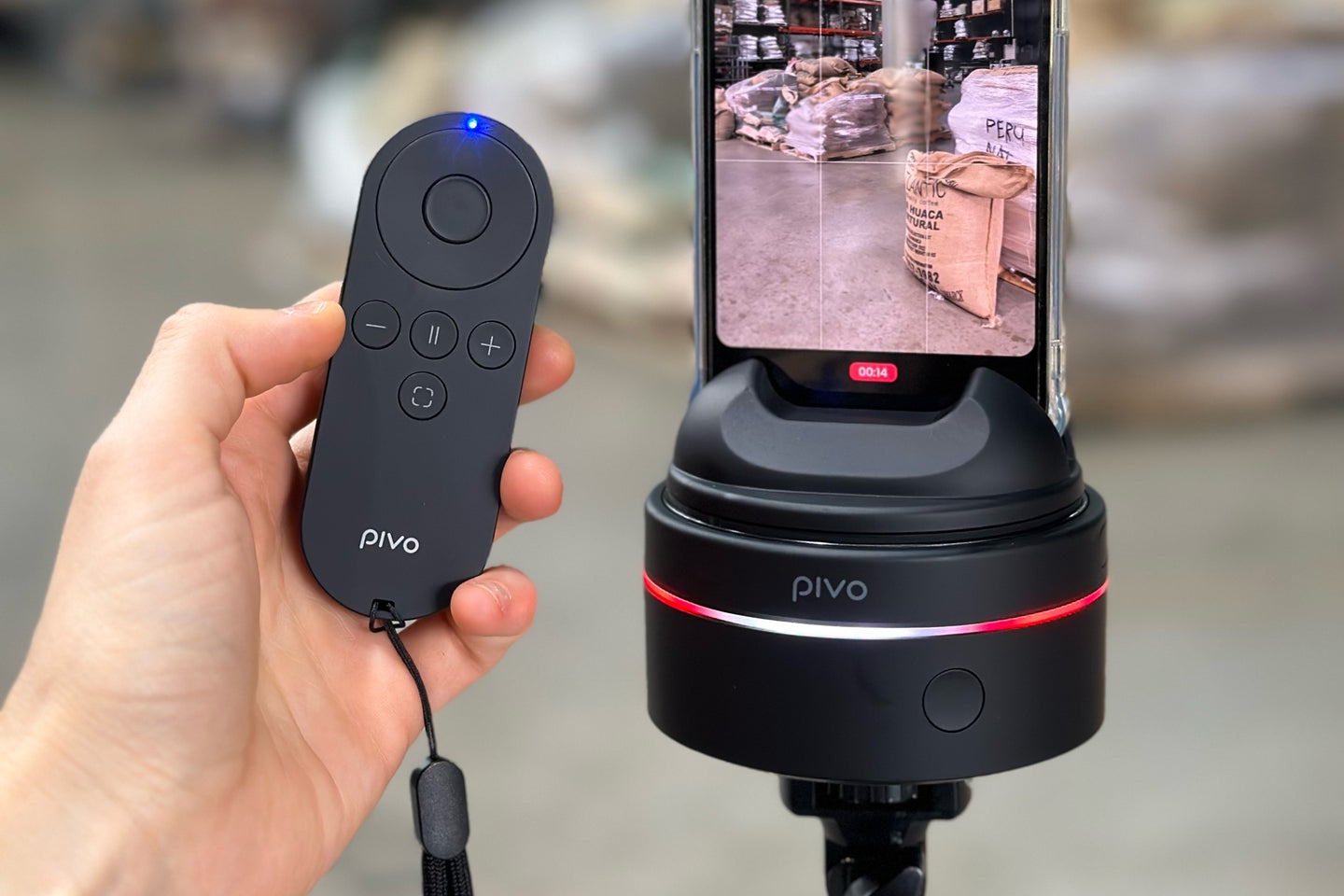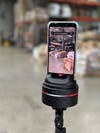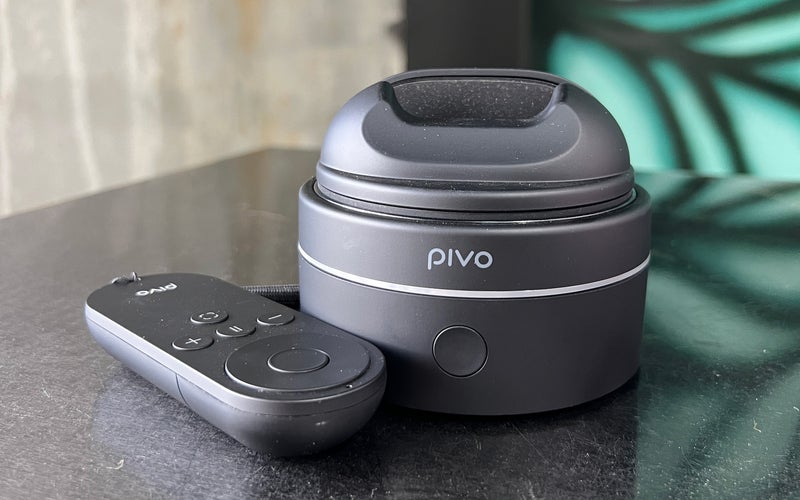Pivo Max review: An auto-tracking option for solo content creation
With multiple functions and points of focus, it allows you to film yourself in action without additional help.

We may earn revenue from the products available on this page and participate in affiliate programs. Learn more ›
A relative newcomer to the camera/tech space, Pivo claims to be “the best way to film yourself.” With three main products—Pivo Pod, Pivo Pod Lite, and Pivo Max—this high-tech camera stand aims AI-powered tracking at athletes, dancers, vloggers, educators, and even equestrians as a hands-free solution to capture dynamic video content without the need for a videographer.
Released in 2022, the Pivo Max is a more powerful, more stable version of the original Pivo Pod motion-tracking smartphone mount. Pivo Max can handle a larger payload (including a tablet or most full-sized digital cameras) with smoother rotation than its predecessors, making it especially useful for creators who film with smartphones or those who use more professional equipment. Pivo sent us the Pivo Max to test out, and overall we’ve been enjoying the experience and freedom that this device offers.
Kat Melheim
Overview: The Pivo Max makes dynamic solo content creation easy and fun. It eliminates the need for a camera person—even when moving around—and increases content options for vloggers, athletes, educators, or anyone looking to create engaging videos of themselves.
Pros
- Easy to setup and use
- Makes dynamic solo filming easy and fun
- Can handle heavy equipment
- High-quality video using Pivo+ app
- Can use front-facing or back cameras on smartphones
- Customizable settings for focus type and tracking speed
- Presets allow you to save your most used settings
Cons
- Remote control doesn’t always work as described
- Not great for filming more than one person or in a crowded area

Pivo Max design & build
The Pivo Max looks and feels well-designed. The minimalist matte black aesthetic gives the Pivo Max a professional, high-tech appearance while allowing functionality to take center stage. It is heavier than it looks, though the weight is what allows it to handle larger pieces of equipment. The base is stable and sits securely on a flat surface. It also includes a ¼-inch UNC thread screw on the bottom for mounting on a tripod.
The top of the Pivo Max also features a ¼-inch UNC thread insert, which secures the included Panoramic Mount. It also works with most standard cameras, as well as other mounting accessories available from Pivo. The included Panoramic Mount easily and securely tightened around my Apple iPhone 13 Pro.
The buttons and ports on The Pivo Max are minimal. One main button turns the Pivo Max on and off. The only other button is an “Alignment Button.” This button seems unnecessary, though, and the explanation in the Quick Start Guide doesn’t offer much clarity. There is a USB-C port to charge the Pivo Max and a covered USB-C port for charging other devices such as your smartphone or camera. However, you can only charge other devices while the Pivo Max is plugged into external power itself. There is also a color-coded LED light built into the circumference of the Pivo Max. This indicates which mode it is in when turned on (pairing, recording, charging, etc).
The Pivo Max is 3 inches tall with the mount (or 1.83 inches without) and weighs 12.55 ounces. The maximum payload is 4.4 pounds. For context, the Sony a7 IV with the 24-70mm f/2.8 GM II lens weighs 2.9 pounds. The device can rotate at a maximum of four seconds per rotation.
Remote control
The remote control is a matching matte black and connects to the Pivo Max via Bluetooth. The buttons are more or less intuitive, and the Quick Start Guide includes a key to help you get started. I found that most of the controls functioned well in-app, though the zoom-in/out didn’t work at all. And although the Quick Start Guide claims you can use the Pivo Max without the Pivo+ app, it never worked for me.
Pivo+ app
Before operating the Pivo Max, you must download the Pivo+ app. The app itself is simple, with a home screen “Gallery” that displays all the photos and videos that you have captured with your Pivo device.
The main interface of the Pivo+ app is where you capture photos and videos, but more on this later. There is also a “Meet” mode and a Beta “Webcam” mode, which I didn’t use much.
Lastly, there is an “Explore” section with additional apps from Pivo, product links to its accessories, and thumbnails that link to YouTube videos with stories from Pivo creators and a limited number of tutorials.
Getting started with Pivo Max
The first time setting up the Pivo Max is simple. It comes partially charged in the box, so you can get going right away. If you want to use the remote control, however, you will need two AAA batteries. The included Quick Start Guide is easy to follow, though I recommend reading the entire guide before getting started. The instructions seemed slightly out of order. It instructs you how to turn on the Pivo Max and pair the remote control before giving directions about downloading the Pivo+ app, which is necessary for using the Pivo Max in the first place. There is also a page detailing how to use the Alignment Button, though it seems unnecessary to do so.
Aside from my momentary confusion and having to download the Pivo+ app after my device was already on, the setup was easy and intuitive. The Pivo Max turns on by pressing the power button for two seconds. The remote control turns on by pressing the center button for two seconds. Pairing the Pivo Max with the remote control is simple and seamless. And you only need to do so the first time you use them together. The Pivo+ app was also easy to pair with the Pivo Max. After the initial pairing, they will automatically pair together the next time you have them all turned on.

Settings and tracking
The AI-powered tech tracks in one of five modes: none, face, body, horse, or dog.
- None: best for use with the remote control and if you want to be the videographer
- Face/Body: great for tracking yourself with the front-facing camera or for tracking someone else with the rear camera. This is the mode I used most.
- Horse/Dog: I didn’t use these modes, but I assume they work best for exactly what they say—tracking a horse or dog in motion
The settings are relatively robust, allowing you to adjust the tracking speed (six speeds from “Slower” to a Beta version of “Turbo”), turn on/off Auto Zoom (which helps create dynamic video), turn on/off Predictive Follow (useful if you occasionally go out of frame), and turn on/off Target Exposure (I don’t know what this setting does).
Another useful feature is the ability to set the AI tracking to keep the subject focused in the center of the frame or to the left or right side. The only issue is that you risk walking out of the frame and losing the tracking altogether.

Using the Pivo Max
Overall, the Pivo Max is easy and intuitive to use. Without the remote, you control the device exclusively from your smartphone. With the remote, you can control the motion from your phone or the remote. It’s worth noting that the first time I used the Pivo Max, the app crashed anytime I recorded more than four minutes. However, I uninstalled and reinstalled the Pivo+ app, and I haven’t had that issue since. I have been able to record up to 25 minutes without a problem.
One issue I found was when trying to film more than one person at a time. At one point, I tried to use the Pivo Max to film myself interviewing another person. However, the Pivo Max would switch focus between me and the other person, often kicking the other person out of frame. The Pivo+ app does include a “lock” feature, which is meant to secure the AI’s focus on whichever person you select. This worked most of the time; however, if I got too close to the person I was interviewing—or if someone walked behind us —the AI would get confused and switch focus when I didn’t want it to.
I primarily used the Pivo Max with the front-facing camera on my iPhone 13 Pro to film myself at work. I am a coffee roaster in a big warehouse where I create educational and “behind-the-scenes” videos. Most of my content includes walking around the warehouse and explaining things to the camera as I go.
Previous to the Pivo Max, I used a static tripod, so I was confined to standing directly in front of the camera. Or I would ask a coworker to film me, which was occasionally awkward, or they were busy. With this device, I am able to stay in the frame as I walk around the room, and I don’t bother my coworkers. Though I have occasionally walked too quickly and put myself out of frame, most of the time, it works great and allows me to capture professional-looking videos I couldn’t otherwise create on my own.

Video quality
The Pivo+ app takes impressively high-quality video, especially from the front-facing camera (what I was using most often on my iPhone 13 Pro). The “auto-zoom” feature maintained focus even up to distances of 30-plus yards across the warehouse. As I walked further away from the camera, the image quality got slightly blurry, but it never detracted from the overall professional impression of the video, especially as the auto zoom and AI-powered panning are so smooth.

Final thoughts
The Pivo Max does exactly what it says it will do—it makes filming yourself easy. Not only that, it makes solo content creation fun and creates dynamic videos with its tracking and auto-zoom features. There is no need for a camera person and no need to spend hours in post-production adding movement to a clip. If you are a solo vlogger looking to make engaging content, an athlete tracking your movements, a cook demonstrating your latest recipe, or an educator creating a lesson, the Pivo Max can enhance the ease and quality of your videos without extra work.
